
Those deep, dark eyes showcase your White German Shepherd’s fierce intelligence and can even get you to part with pieces of your own lunch or dinner – but what does your dog see during the daytime? Differences in color perception, focus and depth perception give your White German Shepherd pup a few advantages over the rest of the family.
How do German Shepherd Eyes Work?
Your White German Shepherd’s eyes are relatively like your own; light passes through the pupil and lens, eventually casting images onto the retina, located at the very back of the eye. Your dog also has an extra eyelid – you may not even notice it; this nictating membrane ensures his vision field stays clear by eliminating dust and debris. He is closer to the ground than you, so more likely to stir up dust when he runs or walks. Without the membrane, that dust could lead to irritation and problems daily.
Motion Matters

White German Shepherds Frost and Maldasha
According to veterinarian ophthalmologist Christopher Pirie, most dogs have what we would consider slight nearsightedness. Most pups have 20/75 vision; working dogs like German Shepherds could be even more nearsighted, since they rely on longer range vision to perform a wide range of jobs. Since your dog doesn’t need to see small items like text close up, you really won’t be able to tell he is nearsighted at all.
Instead of relying on the kind of close vision to read a newspaper, your White German Shepherd instead focuses on movement and color.
While your White German Shepherd is either a hard-working therapy dog, a protection dog or a beloved family pet, she is still a predator at heart. Her prey drive may never come into play, but she is equipped with the kind of vision designed to detect and track moving objects – prey.
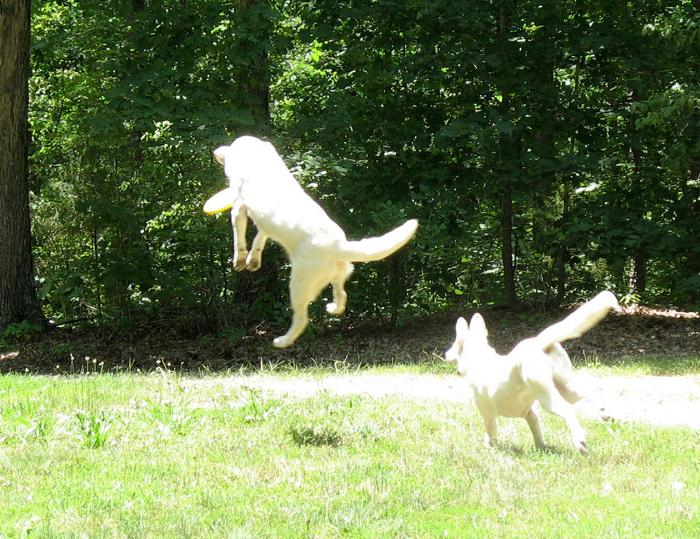
White German Shepherds Deuce and Frost
Animals with eyes that are on the front of the face can accurately track and follow moving objects; this detail is why your dog can snag a frisbee from the air or chase a ball thrown at a distance. What she gives up in near vision, her skill at detecting movement makes her a superior guardian and hunter.
Are White German Shepherds Colorblind?
Your new puppy is not colorblind – but he can’t see quite the full rainbow spectrum that you do. Both human and dog eyes contain cells that detect diverse types of input:
Rods, that detect brightness and light
Cones, that detect colors
A dog naturally has more of the light sensing rods in his eye than the color detecting cones; this leads to enhanced night vision and slightly less color vision that the typical human.
Your dog sees some colors, but not as many as you do, according to a piece in Psychology Today. Most dogs, including German Shepherds, see a range of cool blues, greens and greys – but not very many reds or oranges.
Color vs. Brightness
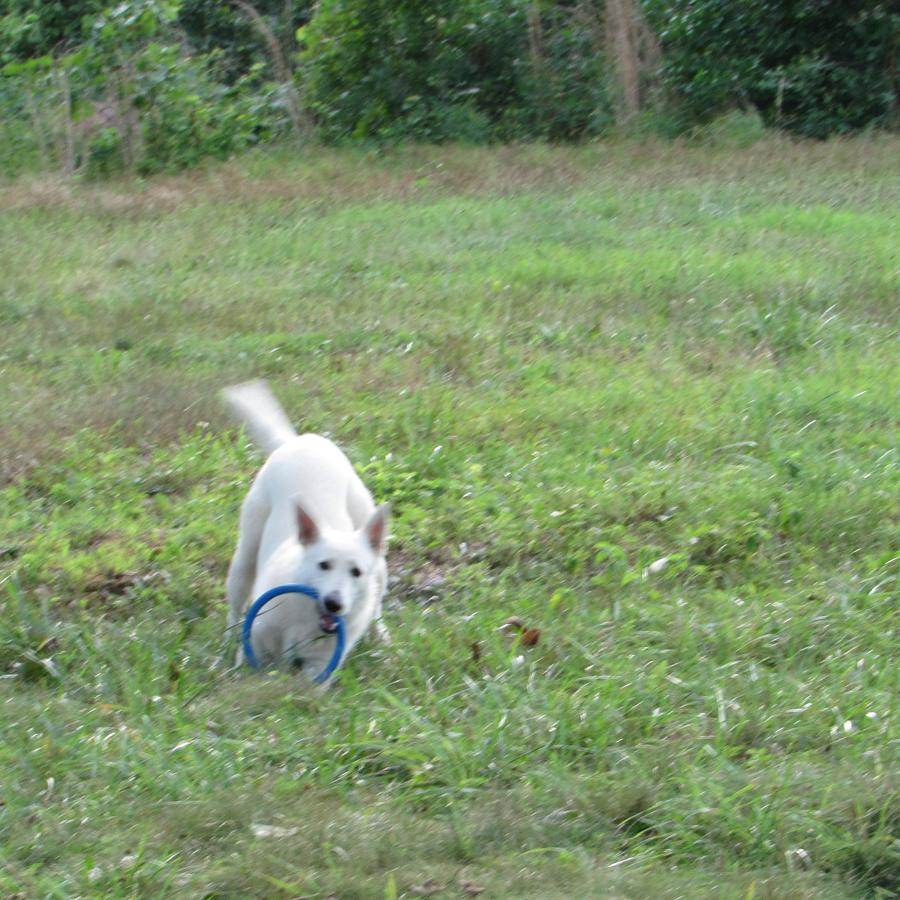
White German Shepherd Snowball
While motion may be the most vital component of day vision, both color and brightness matter to your White German Shepherd during the day. If your dog seems to ignore a red ball but goes crazy for a blue one – -there could be a reason. According to researchers at the Royal Society, dogs prefer color over brightness and may opt for items in their preferred color range over others.
Dogs in a variety of studies responded more positively and consistently to preferred colors rather than increased brightness – so that bright yellow frisbee may be his favorite for a reason.

White German Shepherds Spirit and Arya
Your White German Shepherd’s vision has evolved to make him keenly observant of people and objects at a distance – so he may spot someone approaching far before you do. His lack of color perception doesn’t slow him down, and he may even have some preferred colors.
Learning more about what your dog sees during the day and how he sees it can help you understand his behavior and actions and help you both when it comes to training and performance.

Arctic and Aurora – 5 weeks old
Our latest litter is just beginning to open their eyes and focus on the world around them; stop by and see our newest puppies and watch as your pup’s vision evolves over the first year and beyond.
Your White German Shepherd: What Does He See at Night?
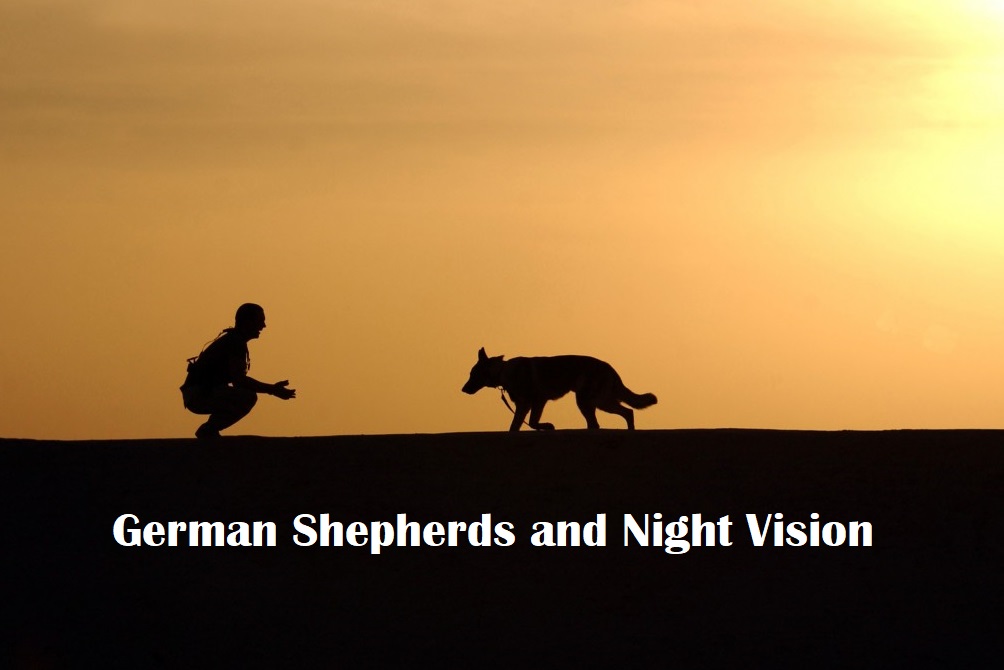
What does your dog see when he patrols the yard at night, or when you go for an evening walk? Most healthy dogs have keen night vision, far better than their human companions; for your White German Shepherd, this ability is particularly important. German Shepherds, with their sharp intelligence and high work drive are already the dog of choice for protection and law enforcement. The ability to see well in the dark only enhances their utility and allows them to move gracefully and navigate safely long after their human companions can’t see a thing.
Since these powerful, clever dogs are motivated to look after their homes and families, night vision is an asset for the White German Shepherd that is a beloved family pet as well. It is not unusual to see one of these fierce protectors do rounds of the yard or home after dark, ensuring every member of the family is safe, secure and where they should be. The ability to see outside at night also helps your German Shepherd protect your home and property and alert you to intruders or danger.
Day vs. Night Vision
A healthy adult German Shepherd has excellent vision during the day, relying on both color and brightness to navigate his environment. She sees fewer colors than you do during the day; only about half of the rainbow or range of colors that you see yourself. While this may seem like a disadvantage, it becomes a significant asset after dark. The reduced color spectrum available to her allows your White German Shepherd to identify brightness, shapes and movement in very low light. You’ll need a special night vision scope to see as well as she does after dark.
Why do Dogs See Better Than Humans at Night?
The shape of the eye itself, along with some adaptive evolution, allows dogs to see better than we do once the sun goes down, according to Comparative Ophthalmology professor Paul Miller, of the Veterinary School at the University of Wisconsin-Madison.
“Dogs have evolved to see well in both bright and dim light, whereas humans do best in bright light. No one is quite sure how much better a dog sees in dim light, but I would suspect that dogs are not quite as good as cats,” which can see in light that’s six times dimmer than our lower limit. Dogs, he says, “can probably see in light five times dimmer than a human can see in.”
Seeing in Low Light
The shape of your White German Shepherd’s eyes makes a difference as well, but eye color does not matter at all. Your dog has a larger pupil than you do – allowing more light to enter the eye. Inside your retina (and your dog’s retina) there are two structures:
Cones, that detect color
Rods, that detect brightness or light
Dogs have more of the light-sensitive rods than the color-detecting cones. This makes them see fewer colors than a human does during the day but allows them to see in far dimmer light. The wider pupil and increased number or rods gives your pet a significant night vision advantage – but that’s not the only thing that is helping him see so much better than you at night.
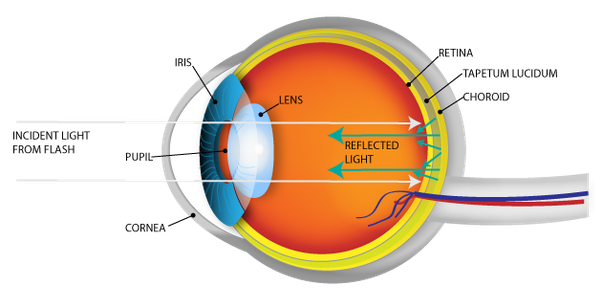
The Tapetum, a Major Night Vision Advantage
While the increased number of rods that are present in your White German Shepherd’s retina help, his biggest advantage is in a mirrorlike structure in the back of the eye called the Tapetum Lucidum. This structure is present in the back of your dog’s eye and helps reflect and bounce light to the retina, increasing her night vision. Since this essential component reflects light, it not only enhances her night vision, it makes her eyes glow in the dark at night.
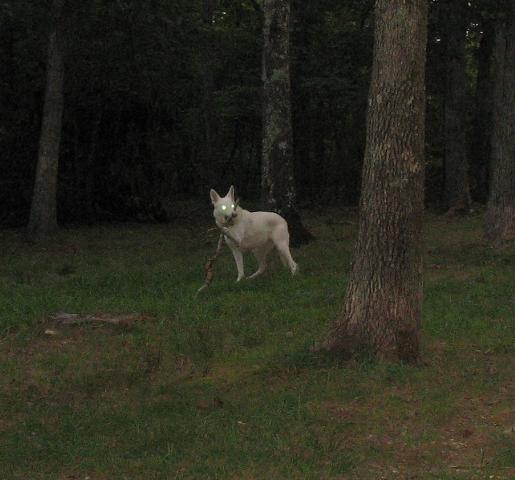
Frosty Cakes
What does this mean for you and your White German Shepherd pup? You’ll have a few advantages during the day – -but you should follow her lead the next time you’re walking down a dark path at night!
Come meet the newest members of the family – our new arrivals are just beginning to open their eyes and see the world around them.